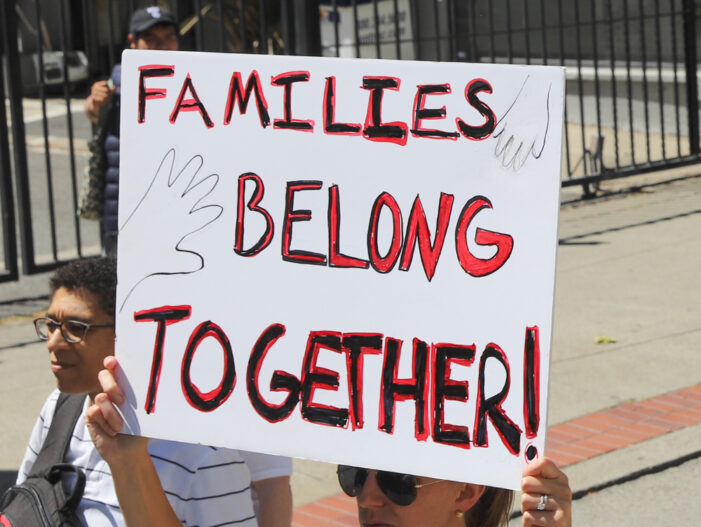By: Juan Avilez | americanimmigrationcouncil.org |Editorial credit: eddie-hernandez.com / Shutterstock.com
The Department of Justice (DOJ) published a list of “sanctuary” jurisdictions on August 5 as a follow up to an executive order issued by President Donald Trump in April. Listing cities, counties, and states, the DOJ contends that these localities impede federal immigration enforcement through alleged “sanctuary jurisdiction characteristics.” These include laws that restrict information sharing between local police and federal immigration agencies or restrict funding to support immigration enforcement, as well as policies that grant non-citizens access to certain public benefits like driver’s licenses.
The list of characteristics is an attempt by the Trump administration to be more specific in its classification of sanctuary jurisdictions and why certain localities made the list – likely in response to the backlash the Department of Homeland Security (DHS) received when it published a much longer list of sanctuary jurisdictions earlier this year. At the time, city leaders and law enforcement officials pushed back against DHS’s classifications, the lack of DHS’s reasoning for inclusion, and the absence of actionable steps to remove themselves from the list.
The latest version of the list features a much smaller number of jurisdictions – the number of counties included dropped from over one hundred to just four – which suggests the DOJ took a more targeted approach to the jurisdictions they listed. However, the “sanctuary characteristics” the DOJ listed lack clarity and mischaracterize the intentions and outcomes of the examples provided.
Why the Characteristics Are Inaccurate
The DOJ’s list of characteristics includes several examples that relate to state restrictions on cooperation by local police departments with Immigration and Customs Enforcement (ICE), including limitations on honoring ICE detainers (a request from ICE to local police to hold an individual in custody beyond the time of their release so that their immigration status can be verified), access to jails, and sharing immigration status information. According to the DOJ, these restrictions hinder ICE’s ability to operate because they prevent local law enforcement and state and local officials from aiding ICE’s operations. However, in reality these policies establish information sharing guardrails, prevent state and local resources from being diverted to federal immigration enforcement, and bolster public safety by focusing on local needs, building community trust, and protecting due process.
States are also well within their legal authority to enact these restrictions. In releasing their list of characteristics, the DOJ leaves out that state and local law enforcement are not required by law to carry out immigration enforcement, a function exclusively designated to the federal government. In reality, many state and local law enforcement agencies even in so-called “sanctuary jurisdictions,” do regularly cooperate with ICE by sending fingerprints of detained individuals to the federal government (which can be used by ICE), honoring court orders or warrants, and participating in other activities mandated under federal law.
The DOJ’s set of characteristics also calls out state and local activities that support immigrant communities, including public declarations of protection and solidarity, establishment of state and local offices dedicated to immigrant newcomers, and other state-level social programs and services designed to support immigrants’ wellbeing and ability to contribute to their new community. These practices do not interfere with ICE’s on-the-ground operations, but DOJ contends that these policies undermine immigration enforcement.
Despite ICE’s claim, state policies that are supportive of immigration participation and inclusion do not undermine or interfere with ICE’s ability to enforce civil immigration law. Instead, they enable cities and states to benefit from the contributions of immigrants to their communities, workforce, and economy. Immigrants contribute significantly to state, local, and federal taxes, and start businesses at higher rates than their native-born counterparts, creating jobs for all residents.
DOJ’s List Threatens ‘Sanctuary Jurisdictions’ Into Revoking Policies That Support Public Safety and Immigrant Communities
The criteria that the DOJ established for sanctuary cities are purposefully mischaracterized to frame lawful policies – that often protect public safety and preserve limited local law enforcement resources – as an obstruction of immigration enforcement. Nonetheless, the Trump administration is moving forward with its executive order that seeks to repeal certain federal funding for sanctuary jurisdictions and is threatening further actions against those that do not change their policies. This pressure is meant to coerce cities and states into cooperating with the administration’s mass deportation agenda, a part of broader efforts to divert resources from local law enforcement to the federal government’s indiscriminate enforcement of immigration laws.
Cooperating with the federal government to advance a mass deportation agenda will require cities and states to divert their own resources — including staffing and direct funding —away from traditional public safety goals and toward helping ICE meet its daily non-citizen arrest quotas. If successful, this would set a new precedent for federal government overreach, where the White House and federal agencies in Washington, D.C. decide how localities should allocate their resources, undermining the trust that local law enforcement agencies have spent decades building with their immigrant residents and resulting in devastating economic impacts for state and local communities.
If welcoming immigrants, promoting their success, and protecting their rights is what it takes to unlock immigrants’ full potential, then the characteristics identified by the DOJ are in fact an investment in community wellbeing and safety – certainly not an impediment to ICE’s ability to do its job. Policies associated with so-called “sanctuary jurisdictions” protect state and local autonomy, prevent federal overreach, uphold due process, and establish important guardrails that keep local resources focused on community priorities.

